北师大版初中英语八年级上册Unit6_Lesson16_精品教案Ⅰ
- 格式:pdf
- 大小:787.30 KB
- 文档页数:8



Unit 6 Lesson 16 Natural Abilities 教案Teaching aims:1. 进行课堂阅读训练,提高学生英语阅读能力。
2. 将课文主题与生活紧密联系,培养学生在生活中学习英语、运用英语的能力。
3. 对过去进行时进行归纳整合。
Key points:复习过去进行时。
Difficult points:引导学生在活动中、生活中灵活运用句型,培养学生英语听、说能力。
Teaching preparations:PPT, cards, pictures, recorder.Teaching procedures:Step 1: Warm-up1. Greeting:T: Good morning, girls and boys.2. Lead-inLook at the key words. Then make sentences about these things.Key Words: Senseshear see smell taste touch(feel)cheese air water sunExample:You can see, smell, taste and feel cheese but you can’t hear it!Step 2: Reading1. Read the two interviews. Write the correct question in each bank.1) What did you do?2) What was happening on the farm?3) What happened then?4) What were you doing when it happened?2. Now answer the interview question using your own words.Step 3: Your TurnGuess and write sentences about what your partner was doing at these times.1) yesterday afternoon2) one hour before he/ she had dinner last night3) at 8 pm last night4) at 7 am this morning5) before English class startedExample:Yesterday afternoon, he/ she was studying at school.Step 4: SpeakingT: Work in pairs. Check your guesses in Your Turn.Example:A: What were you doing yesterday afternoon?B: I was studying at schoolStep 5: Homework1. Memory all the key words and expressions.2. Do you think some people or animals have unusual skills? Write down your own opinion.。

Unit6 Lesson16 精品教案Ⅰ教材分析本课是北师大版?初中英语?八年级上册教材第6单元的第16课,话题为动物本能。
本课主要了讲述了两段采访。
第一段采访的内容为Tom家的狗在旅行过程中丧失了。
通过它的本能行走了150公里又回到了主人身边。
第二段采访讲的是动物们的异常表现成功地预示了地震的即将到来。
这两个小故事情节跌宕起伏,扣人心弦,其中也表达了动物与人之间深深的情感。
本课的教学设计分为两个课时。
第一课时侧重对阅读内容的理解,引导学生通过阅读获取事情发生的时间、地点、经过和结果的信息。
在阅读活动中,既注重整体阅读,也引导学生提取细节信息,并关注事情的开展和动物和人的感受,最后结合对话信息和语言进展输出性活动。
通过本课学习,引导学生尊重动物本能,增强保护动物的意识。
第二课时在复习课文内容和语言的根底上,引入本课语法工程为过去进展时。
学生在理解其语意功能的根底上,反复操练,最后在输出活动中学生能够根据具体问题,恰当使用过去进展时,描述过去发生的某一时刻的精彩瞬间。
教学内容话题:动物本能词汇:Lesson 16: natural, sense, smell, taste, touch, amazing,relax, disappear, search, yard, fence, strangely, noise, wake五级词汇:natural, sense, smell, taste, touch, relax, search, yard, strange, noise, wake.课标外词汇:amazing, disappear, fence, strangely,⑵按照话题分类:Feelings and moods: sense, smell, taste, toucNature: disappear, search, yard, fence, strangely, noise, wake, natural策略:读前预测;读中通过关键词获取主要信息;通过并列句、上下文语境猜想词义。




Unit 6 Lesson 16 Natural Abilities(第二课时)Lesson Focus•Senses, prepositions and adverbs•Past continuous and past simple•Guessing what your partner was doing at a particular time Grammar: Past continuous and past simpleExercise 5Purpose: to help students plete a table with the past continuous or past simple form of verbsDirect students to the reading in Exercise 2. Have a student volunteer to read the first sentence aloud. Write the sentence on the board. Ask “What are the two actions in the sentence?”Elicit or provide Tom and his family were returning from a trip and their dog disappeared. Ask “What's the tense, past, present or future?”Elicit past. Then ask “Which was the first action?”Elicit or provide Tom and his family were returning from a trip. Ask“What happened to interrupt the first action?”Elicit or provide Their dog disappeared. Ask“Which past tense do we use to show that action interrupts the first action?”Elicit or provide past simple. Then ask“Which past tense do we use to indicate an action that is ongoing?”Elicit or provide past continuous.Revise how to form the past continuous, eliciting or providing past tense of be (was, were) + ing form of verb ( also called the presentparticiple). As well, revise how to form past simple (Add d or ed to the base form, unless irregular. ), going over a few irregular verbs. If you feel your students are ready, you may skip this step.Say““plete the table with the past simple or past continuous”. Monitor, offering help as needed. If students need support, have them work in pairs.Go over the answers, asking individual students to read the sentences aloud. Challenge students to identify the first, ongoing action and the action that interrupted it.Answers1. was sleeping;2. woke;3. opened;4. were;5. wasn't;6. doing:7. happenedExercise 6Purpose: to help students guess and write sentences about what their partner was doing at specific times in the pastDirect students to the list of times. Read them aloud or have a student read them. Make sure students understand the meaning. Say a true sentence about yourself, for example,“Yesterday afternoon, I was riding on the train”Assign students partners, but don't put them into pairs yet, and say“Now guess and write sentences about what your partner was doing at these times”. Monitor, offering help as needed.Direct students to the chart in Exercise 5 if necessary.Have students pare their sentences with a different partner. Encourage them to offer each other corrective feedback. Monitor closely as students do this, making sure they are giving correct feedback. Go over some examples as a class if necessary.SpeakingExercise 7Purpose: to help students check their guesses from Exercise 6Say the true sentence about yourself again and write it on the board.Underline riding on the train and ask students to tell you the question word for the statement. Elicit or provide What? As a class, e up with the question to ask for the first time: What were you doing yesterday afternoon? Alternatively, read the Example aloud. If you feel your students are ready, you may skip this step.Direct students to the sentences they wrote in Exercise 6. Say " Now meet with your partner. Check your guesses in Exercise 6. Ask and answer questions". Monitor, offering help as needed. Make a list of any serious errors in past continuous and simple past usage and have an anonymous feedback session at the end of the activity. Expansion: Don't Stop!Note: Use these activities to give students more practice.Activity 1: Personalise the activity by either writing the following list on the board, or by making a sheet with them. Begin the list like this:What were you doing ...?⭕on 9/11⭕when the earthquake of 2010 hit⭕on the first day of your junior high schoolYou can also make this into a“bluff game”by telling students who don't remember what they were doing to make something up. Their partners can then guess whether the answer is true or not.Activity 2: If you did not do the Expansion exercise "Alibi!" from Unit 5, do it now.。

北师大版英语八上Unit 6 Lesson 16 Natural Abilities 教学设计一. 教材分析北师大版英语八上Unit 6 Lesson 16 Natural Abilities主要讲述人们对于天赋和技能的看法。
通过本节课的学习,学生能够掌握各种天赋和技能,学会如何表达自己的观点,提高他们的阅读和写作能力。
本节课的主要内容包括动物的天赋和人类的学习技能。
二. 学情分析学生在学习本节课之前,已经掌握了基本的英语语法和词汇。
但是,对于一些关于天赋和技能的词汇,他们可能还没有接触过。
此外,学生可能对于如何表达自己的观点还存在一定的困难。
三. 教学目标1.学生能够掌握关于天赋和技能的词汇和短语。
2.学生能够理解课文内容,把握文章的主旨大意。
3.学生能够运用所学知识,表达自己的观点。
4.学生能够提高他们的阅读和写作能力。
四. 教学重难点1.词汇:动物的天赋和人类的学习技能相关的词汇。
2.语法:一般现在时态的运用。
3.表达:如何表达自己的观点。
五. 教学方法1.任务型教学法:通过完成各种任务,激发学生的学习兴趣,提高他们的实践能力。
2.合作学习:学生分组讨论,培养他们的团队协作能力。
3.情境教学法:创设各种情境,让学生在真实的语境中学习英语。
六. 教学准备1.教学PPT:包括课文内容、词汇、语法、练习等。
2.课文录音:方便学生跟读和模仿。
3.相关图片和视频:用于创设情境,激发学生的学习兴趣。
七. 教学过程1.导入(5分钟)利用图片和视频,引导学生谈论动物的天赋和人类的学习技能。
例如,展示一些动物的捕猎和生存技巧,让学生谈谈对这些动物天赋的看法。
2.呈现(10分钟)向学生介绍本节课的主要内容,包括课文标题、作者、主要人物和事件。
让学生快速阅读课文,了解文章大意。
3.操练(10分钟)学生分角色朗读课文,模仿语音语调。
教师针对学生的发音和语调进行纠正和指导。
接着,学生进行词汇练习,运用本节课所学的新词汇。


Unit 6 Lesson 16 Natural Abilities 教学设计教学内容:北师大版英语八年级上册Unit 6 Lesson 16 Natural Abilities 部分内容。
教学目标(Objectives):1.确保学生认识和理解一些基本单词的意义和简单口头运用(To learn the meaning and simple usages of some words and phrases)。
2.学习使用本单元重点句型及表达(To use the typical sentences to express)。
3.鼓励学生大胆发言及表达(To encourage the students to express bravely)。
4.培养学生对英语学科的兴趣(To make the students interest in English learning)。
5.增强学生听说读写译的能力(To strengthen the ability of listening, speaking, reading, writing and translating)。
教学重点(Key Points):在学习了单词的基础上,以单词为载体,进行主要句型的学习,并了解其中的语法现象,根据具体情境,学会交流对话,侧重句型语法学习,交际意向和课外拓展为重点。
了解动物的本能,尊重爱护动物。
教学方法:游戏,音频,情景教学法,Pair-work两人小组活动,Group-work小组活动,多媒体辅助教学。
教学难点:学生处于初中阶段,对英语有了初步了解,有了一定的词汇储备,对于八年级上学期学生的要求重点是在会读会说的基础上,能掌握一些基本单词的拼写和造句,了解一定的语法内涵,与人进行简单沟通交流。
教学准备:课件、照片素材、音频文件、教学道具。
教学设计:Step1. GreetingStep2.Warm-up/Leading(热身/课程导入)Warm-up Question1. Read the two interviews. Write the correct question in each bank.1) What did you do?2) What was happening on the farm?3) What happened then?4) What were you doing when it happened?...Step3.Presentation(呈现新课)1.Words Learning!1)老师放映课件,用中文询问同学看到了什么?同学们会看到课件上呈现的图画。